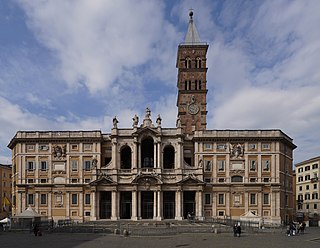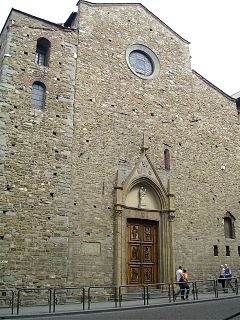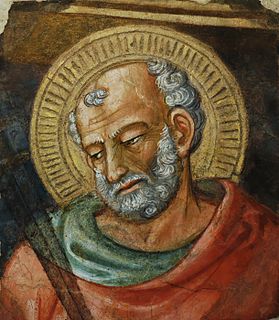
Altobello Persio (1507-1593) was an Italian sculptor. He was the father of Antonio, a philosopher, Ascanio, a humanist, Domizio, a painter, and Giulio Persio, a sculptor.

Altobello Persio (1507-1593) was an Italian sculptor. He was the father of Antonio, a philosopher, Ascanio, a humanist, Domizio, a painter, and Giulio Persio, a sculptor.
Persio was born at Montescaglioso. His first known works were sculptures in the local Abbey of San Michele Arcangelo, such as the Renaissance-style portal. After marrying Beatrice Goffredo, a noblewoman from Matera, he moved to the latter city, where he executed some of his most important works: these include the stone nativity scene and a frontal altar in the Cathedral.
Among his other works are a "Crucifix" and a "Virgin with St. John" in the church of San Nicola at Lagonegro, a "St. Joseph" and "Pietà" in the lunette of the portal of Mother Church of Santa Maria Maggiore at Miglionico (also attributed to his son Giulio), "St. Peter and Paul" in the Mother Church of Oppido Lucano, Isabella and Frederick of Aragon in the Mother church of Ferrandina, and a stone nativity scene in the crypt of della chiesa di Santa Maria Maggiore in the quarter of Rabatana at Tursi.

Paolo Uccello, born Paolo di Dono, was a Florentine painter and mathematician who was notable for his pioneering work on visual perspective in art. In his book Lives of the Most Excellent Painters, Sculptors, and Architects, Giorgio Vasari wrote that Uccello was obsessed by his interest in perspective and would stay up all night in his study trying to grasp the exact vanishing point. While his contemporaries used perspective to narrate different or succeeding stories, Uccello used perspective to create a feeling of depth in his paintings. His best known works are the three paintings representing the battle of San Romano, which were wrongly entitled the Battle of Sant'Egidio of 1416 for a long period of time.

Lorenzo di Pietro, known as Vecchietta, was an Italian Sienese School painter, sculptor, goldsmith, and architect of the Renaissance. He is among the artists profiled in Vasari's Le Vite delle più eccellenti pittori, scultori, ed architettori.

The Basilica of Saint Mary Major, or church of Santa Maria Maggiore, is a Major papal basilica as well as one of the Seven Pilgrim Churches of Rome and the largest Catholic Marian church in Rome, Italy.

Francisco Salzillo y Alcaraz was a Spanish sculptor. He is the most representative Spanish image-maker of the 18th century and one of greatest of the Baroque. Francisco Salzillo worked exclusively on religious themes, and almost always in polychromed wood. He made hundreds of pieces that are distributed throughout the Region of Murcia and some in bordering provinces. The Spanish Civil War (1936–1939) caused the destruction of many of the works of Salzillo. Some of his masterpieces include his nonprocessional religious work, his processional work, and his great Nativity scene.

Carlo Maratta or Maratti was an Italian painter, active mostly in Rome, and known principally for his classicizing paintings executed in a Late Baroque Classical manner. Although he is part of the classical tradition stemming from Raphael, he was not exempt from the influence of Baroque painting and particularly in his use of colour. His contemporary and friend, Giovanni Bellori, wrote an early biography on Maratta.

Cosimo Fanzago was an Italian architect and sculptor, generally considered the greatest such artist of the Baroque period in Naples, Italy.

Santa Maria Maggiore di Firenze is a Romanesque and Gothic-style, Roman Catholic church in Florence, region of Tuscany, Italy. This is among the oldest extant churches in Florence.

Domenico Antonio Vaccaro was an Italian painter, sculptor and architect. He created many important sculptural and architectural projects in Naples. His later works are executed in an individualistic Rococo style.

Cesare Nebbia (c.1536–c.1614) was an Italian painter from Orvieto who painted in a Mannerist style.

Bicci di Lorenzo (1373–1452) was an Italian painter and sculptor, active in Florence.
Dionisio Lazzari was an Italian sculptor and architect.

The Blessed Virgin Mary has been one of the major subjects of Western Art for centuries. Numerous pieces of Marian art in the Catholic Church covering a range of topics have been produced, from masters such as Michelangelo and Botticelli to works made by unknown peasant artisans.

Matera Cathedral is a Roman Catholic cathedral in Matera, Basilicata, Italy. It is dedicated to the Virgin Mary under the designation of the Madonna della Bruna and to Saint Eustace. Formerly the seat of the Bishops, later Archbishops, of Matera, it is now the cathedral of the Archdiocese of Matera-Irsina.

Christianity and religion in general has always been an important part of the social and cultural life of Naples. It is the seat of the Archdiocese of Naples, and the Catholic faith is highly important to the people of Naples and there are hundreds of historic churches in the city. The Cathedral of Naples is the most important place of worship in the city, each year on September 19 it hosts the Miracle of Saint Januarius, the city's patron saint. In the miracle which thousands of Neapolitans flock to witness, the dried blood of Januarius is said to turn to liquid when brought close to relics said to be of his body: this is one of the most important traditions for Neapolitans.
Nicolas Cordier (1567–1612), was a French sculptor, painter and printmaker working in Rome and also known as "il Franciosino", Nicholas Cordier, or Niccolò da Lorena.

Antonio Brilla was a prolific Italian sculptor and ceramic artist mainly active in Liguria. He travelled in 1838 to Florence to study masterworks, where he met Giovanni Duprè and Lorenzo Bartolini. He returned to Savona to establish a studio. Two of Antonio's sons also were artists.

San Martino church, also called San Martino Maggiore is a Gothic-style, Roman Catholic church located at the corner of Via Marsala and Via Guglielmo Oberdan in Bologna, region of Emilia Romagna, Italy. The church was founded by the adjacent Carmelite monastery. On 25 August 1941, Pope Pius XII elevated it to the status of basilica and imposed on the Archbishop of Bologna, Mario Corneliano to Pontifically crown the venerated Marian image of Our Lady of Carmel since 10 August 1704 via the authority of the Vatican Chapter under Pope Clement XI.

The Artistic Patronage of the Neapolitan Angevin dynasty includes the creation of sculpture, architecture and paintings during the reigns of Charles I, Charles II and Robert of Anjou in the south of Italy.

The Basilica of San Giovanni Maggiore is a church in Largo San Giovanni Maggiore in central Naples, Italy.

Santa Maria dei Servi, or simply known as the Chiesa dei Servi, or more fully as the Church of the Nativity of the Servants of the Blessed Virgin Mary, is a 14th-century, Roman Catholic church that faces the Via Roma in Padua, region of the Veneto, Italy. This is the parish church in the vicariate of the Cathedral Basilica of Santa Maria Assunta governed by the Servite Order. The church contains outstanding works of art including a wooden crucifix by Donatello.